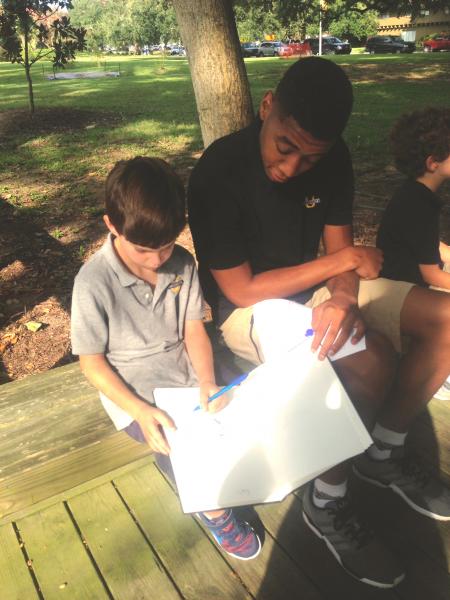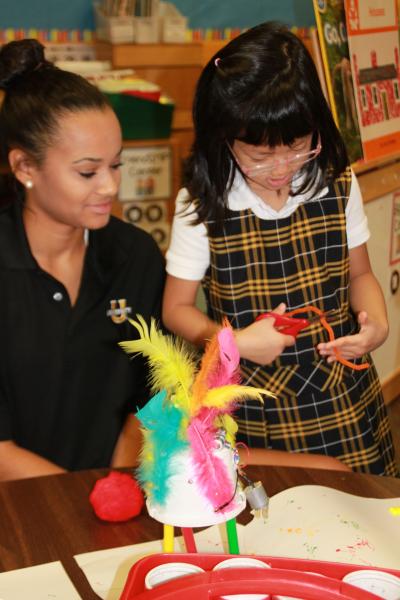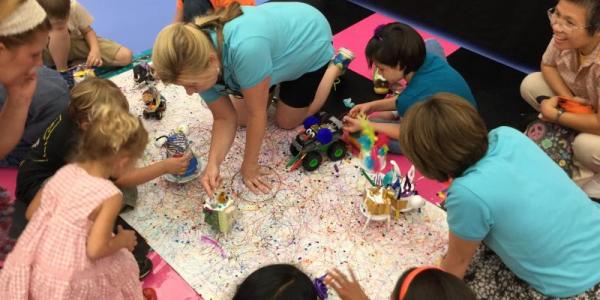Paige Zittrauer challenged her kindergarten students and their high school art student project partners: Make a contraption that moves on its own across a piece of paper and leaves a mark in its path.
Intrigued by the challenge, the kindergartners looked at a few examples of how “scribbling machines” move and then watched several other videos. The high school students were given an excerpt from an online project guide about scribbling machines.
The kindergarten children and their high school project partners followed an engineering design process to create their scribbling machines: plan; build/create; try it out; improve; and then share.
STEP ONE: PLAN
 The kindergarten-high school partners imagined what their scribbling machine might look like. They made a plan and sketched their ideas. Paige invited them to bring something from home or use materials from the classroom as a base.
The kindergarten-high school partners imagined what their scribbling machine might look like. They made a plan and sketched their ideas. Paige invited them to bring something from home or use materials from the classroom as a base.
STEP TWO: BUILD OR CREATE
Teams were given a 1.5 volt hobby motor, a glue stick, and a AA battery. Together, they selected art materials and loose parts. With plans in hand, they created their scribbling machines. Most placed a piece of a glue stick on the tip of the motor like they had seen in the videos. Others tried something different, such as a small section of Mardi Gras beads attached to the motor's tip.
STEP THREE: TRY IT
Would it it work? The kindergartners and high school students were not given step-by-step directions. They were given enough information to get started and were encouraged to tinker. They connected the battery to the motor and watched what happened. Most of the scribbling machines turned on, but they did not move across the paper. What was wrong?
The kindergartners and their high school student partners speculated about why the machines didn’t move:
- My battery was dead.
- Our scribbling machine was too heavy.
- Our motor didn’t work.
STEP FOUR: IMPROVE OR MAKE BETTER
 The next time the groups met, they compared the machines that moved across the paper with ones that didn’t. A battery tester was available for those who believed the battery was the problem. Teams noticed that the machines which moved had glue sticks in different positions from those which didn’t move. The teams soon realized was that the motor needed to be off-balance for the machine to move across the paper. They adjusted the glue sticks on the ends of the motors so they weren’t centered. Success! The teams were delighted and many tried to improve or make their machines better. Some added two motors and extra batteries to find out if they could make their machine move faster. A few children made adjustments and tried to race their scribbling machines against other machines.
The next time the groups met, they compared the machines that moved across the paper with ones that didn’t. A battery tester was available for those who believed the battery was the problem. Teams noticed that the machines which moved had glue sticks in different positions from those which didn’t move. The teams soon realized was that the motor needed to be off-balance for the machine to move across the paper. They adjusted the glue sticks on the ends of the motors so they weren’t centered. Success! The teams were delighted and many tried to improve or make their machines better. Some added two motors and extra batteries to find out if they could make their machine move faster. A few children made adjustments and tried to race their scribbling machines against other machines.
STEP FIVE: SHARE
All of the scribbling machines were on display at the Baton Rouge Mini Maker Faire at a public library. Over 2,000 people--children and families--participated.Children could select one of the scribbling machines and test it out on a large piece of paper on the floor. Children of all ages squealed with delight as they worked with the machines.
Some teachers might think they don’t have time for STEAM experiences like this one given the strong emphasis on literacy in kindergarten. Not only did children learn science, technology, engineering and math concepts, and vocabulary (e.g., rotate, off-balance, circuit), but Paige integrated literacy throughout the project. The children participated in shared writing during planning, and functional writing as they made lists of materials and wrote directions. After the activity, they wrote thank-you notes to their high school buddies and responded to writing prompts such as:
- Tell one thing new that you learned from building your scribbling machine.
- Tell how you can build your scribbling machine better the next time you build one.
This activity is a wonderful example of how children construct their own understanding of ideas and phenomena as they tinker and build things with their hands. It also demonstrates how teachers can create engaging, developmentally appropriate activities while meeting rigorous learning standards.
Interested in doing this in your classroom? The scribbling machines activity was inspired by this resource from the Exploratorium, an online science and art lab.
What Children Learned
The following is a comprehensive list of the different areas of learning this activity touched on:
Social/Emotional Development
- Works cooperatively with others
- Takes turns
- Follows limits and expectations
- Solves social problems
Physical Development
- Develops fine motor skills
- hand–eye coordination
- dexterity
Cognitive Development
- Solves problems
- Thinks logically and reasons
- Plans
- Develops positive approaches to learning
- attention and engagement
- persistence
- flexible thinking
- creativity
- curiosity and motivation
Language Development
- Listens and follows directions
- Expresses self
- Asks questions
- Engages in conversations
- Uses and expands content-based vocabulary
Literacy
- Interacts during integrated, content-focused read-alouds
- Participates in shared writing experiences
- Uses functional writing
- Writes to convey meaning and communicate
Mathematics
- Explores geometric shapes and ideas
- Measures
- Explores spatial relationships
Science, Engineering, and Technology
- Observes, asks questions, and investigates
- Follows engineering design process
- Engages in physical science discoveries
- how things move
- forces
- beginning circuitry (batteries, motors)
- Uses tools and technology to perform tasks
The Arts
- Expresses self creatively
- Creates 3-D structures
- Uses a variety of art tools and materials
Interested in how this activity integrates with standards for NAEYC Accreditation of Programs for Young Children? Learn more in this short essay on connecting authentic learning to standards.
Cate Heroman is one of the founders of Knock Knock Children’s Museum in Baton Rouge, Louisiana, renowned for its emphasis on early literacy and early STEAM education. A nationally recognized educator and author of numerous publications, she has been an early childhood educator, state administrator, trainer, facilitator, keynote speaker, and developer of curriculum and assessment materials.

Paige Zittrauer teaches kindergarten at the University Laboratory School on Louisiana State University’s campus in Baton Rouge. She also volunteers for Knock Knock Children’s Museum.
